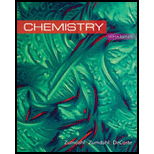
(a)
Interpretation:
The activity of curie for given set of compounds with given mass should be calculated.
Concept Introduction:
Half-life: It can be defined as the time taken to decay half of the initial amount of the given element.
Decay constant (k): It is the constant value which gives the ratio of the number of atoms present in the substance that decays in given time period compared with the total initial number of atoms present.
The relationship between half-life period and the decay constant are depicted as follow Half-life: It can be defined as the time taken to decay half of the initial amount of the given element.
Decay constant (k): It is the constant value which gives the ratio of the number of atoms present in the substance that decays in given time period compared with the total initial number of atoms present.
The relationship between half-life period and the decay constant are depicted as follow
(b)
Interpretation:
The activity of curie for given set of compounds with given mass should be calculated.
Concept Introduction:
Half-life: It can be defined as the time taken to decay half of the initial amount of the given element.
Decay constant (k): It is the constant value which gives the ratio of the number of atoms present in the substance that decays in given time period compared with the total initial number of atoms present.
The relationship between half-life period and the decay constant are depicted as follow Half-life: It can be defined as the time taken to decay half of the initial amount of the given element.
Decay constant (k): It is the constant value which gives the ratio of the number of atoms present in the substance that decays in given time period compared with the total initial number of atoms present.
The relationship between half-life period and the decay constant are depicted as follow
Want to see the full answer?
Check out a sample textbook solution
Chapter 19 Solutions
Chemistry
- Don't use ai to answer I will report you answerarrow_forwardConsider a solution of 0.00304 moles of 4-nitrobenzoic acid (pKa = 3.442) dissolved in 25 mL water and titrated with 0.0991 M NaOH. Calculate the pH at the equivalence pointarrow_forwardWhat is the name of the following compound? SiMe3arrow_forward
- K Draw the starting structure that would lead to the major product shown under the provided conditions. Drawing 1. NaNH2 2. PhCH2Br 4 57°F Sunny Q Searcharrow_forward7 Draw the starting alkyl bromide that would produce this alkyne under these conditions. F Drawing 1. NaNH2, A 2. H3O+ £ 4 Temps to rise Tomorrow Q Search H2arrow_forward7 Comment on the general features of the predicted (extremely simplified) ¹H- NMR spectrum of lycopene that is provided below. 00 6 57 PPM 3 2 1 0arrow_forward
 Chemistry: The Molecular ScienceChemistryISBN:9781285199047Author:John W. Moore, Conrad L. StanitskiPublisher:Cengage Learning
Chemistry: The Molecular ScienceChemistryISBN:9781285199047Author:John W. Moore, Conrad L. StanitskiPublisher:Cengage Learning ChemistryChemistryISBN:9781305957404Author:Steven S. Zumdahl, Susan A. Zumdahl, Donald J. DeCostePublisher:Cengage Learning
ChemistryChemistryISBN:9781305957404Author:Steven S. Zumdahl, Susan A. Zumdahl, Donald J. DeCostePublisher:Cengage Learning Chemistry: An Atoms First ApproachChemistryISBN:9781305079243Author:Steven S. Zumdahl, Susan A. ZumdahlPublisher:Cengage Learning
Chemistry: An Atoms First ApproachChemistryISBN:9781305079243Author:Steven S. Zumdahl, Susan A. ZumdahlPublisher:Cengage Learning
 Introductory Chemistry: A FoundationChemistryISBN:9781337399425Author:Steven S. Zumdahl, Donald J. DeCostePublisher:Cengage Learning
Introductory Chemistry: A FoundationChemistryISBN:9781337399425Author:Steven S. Zumdahl, Donald J. DeCostePublisher:Cengage Learning Chemistry for Engineering StudentsChemistryISBN:9781337398909Author:Lawrence S. Brown, Tom HolmePublisher:Cengage Learning
Chemistry for Engineering StudentsChemistryISBN:9781337398909Author:Lawrence S. Brown, Tom HolmePublisher:Cengage Learning





